Agentic AI is moving from pilot projects to board-level decisions. The real challenge now is knowing which questions actually expose the risks beneath the surface.
It’s not enough to debate models, benchmarks, or vendor roadmaps. For any enterprise serious about operationalizing agentic AI and absorbing its risks the real conversation happens upstream, before even a single deployment is approved.
What follows isn’t a list of features to evaluate. These are the high-stakes questions that will shape whether agentic AI becomes a scalable asset or an operational liability. The organizations willing to confront them early will avoid far costlier decisions downstream.
1.Can my agents work across fragmented systems or only inside clean demos?
Why This Becomes a Failure Point:
Enterprises rarely operate on unified, pristine data infrastructures. Legacy systems, disconnected data stores, third-party APIs, and human-maintained spreadsheets drive large portions of critical operations. The question isn’t whether agentic AI can generate output; it’s whether it can function inside the data and system fragmentation that defines real businesses.
In sectors like higher education and financial services, agents may need to coordinate across Student Information Systems (SIS), CRMs, legacy KYC platforms, and dozens of departmental databases, none of which were designed to interoperate cleanly.
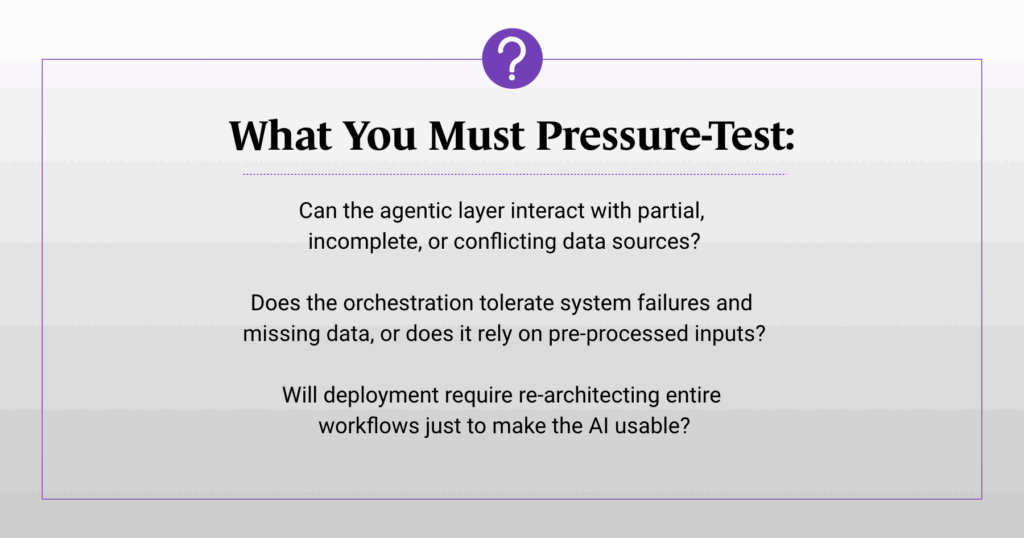
What Mature Agentic AI Gets Right:
Mature agentic AI doesn’t demand clean slates. It’s built for orchestration: negotiating incomplete information, coordinating across disconnected systems, and tolerating real-world imperfections without collapsing. The test isn’t how well the demo runs; it’s how resilient the agent is inside your operational entropy.
2.How explainable are the decisions and will auditors trust them?
Why This Becomes a Failure Point:
In regulated industries, opaque decisions are not simply technical risks. They’re legal and reputational liabilities. “The model said so” is not a defensible audit response when regulators or stakeholders demand accountability.
This is especially acute in insurance underwriting, credit adjudication, and healthcare eligibility where downstream impacts of opaque decisions affect real people’s access to financial services, care, or protection.
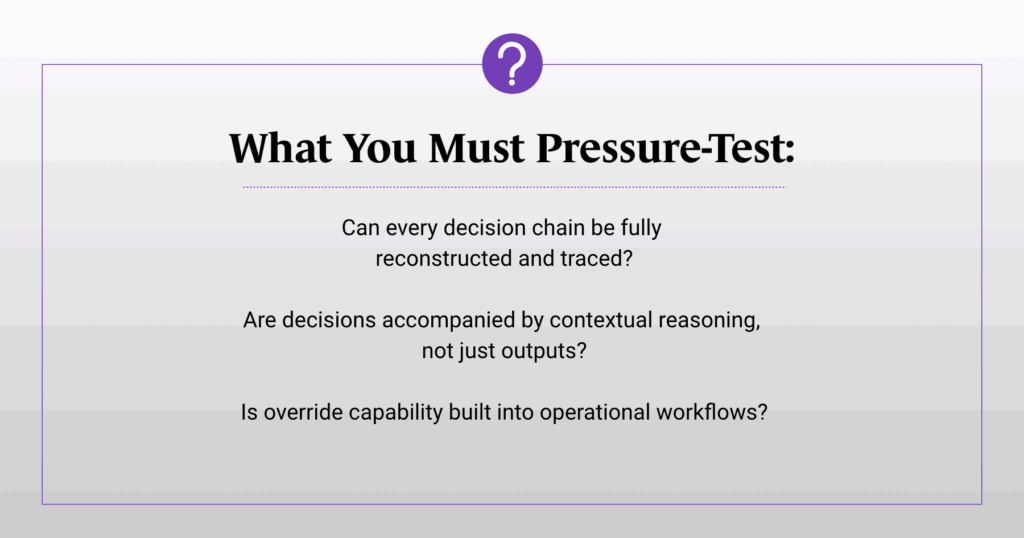
What Mature Agentic AI Gets Right:
Explainability isn’t a reporting feature; it’s an architectural foundation. Robust agentic systems log not only decisions but the intent, data context, and escalation paths that informed them. Mature buyers evaluate AI partners on how deeply explainability is embedded into system design, not how quickly a vendor can add audit logs post-fact.
3.Can agents coordinate across functions or will I be stitching together disconnected bots?
Why This Becomes a Failure Point:
Much of today’s automation still operates in silos: one system for claims, another for customer service, another for fraud detection. Agentic AI’s promise lies in multi-domain coordination: agents that can communicate, negotiate, and resolve issues across organizational boundaries without constant human arbitration.
In consumer products and ecommerce, for example, demand spikes driven by viral trends may require agents to coordinate live inventory, supplier logistics, customer notifications, and returns orchestration, all in real time.
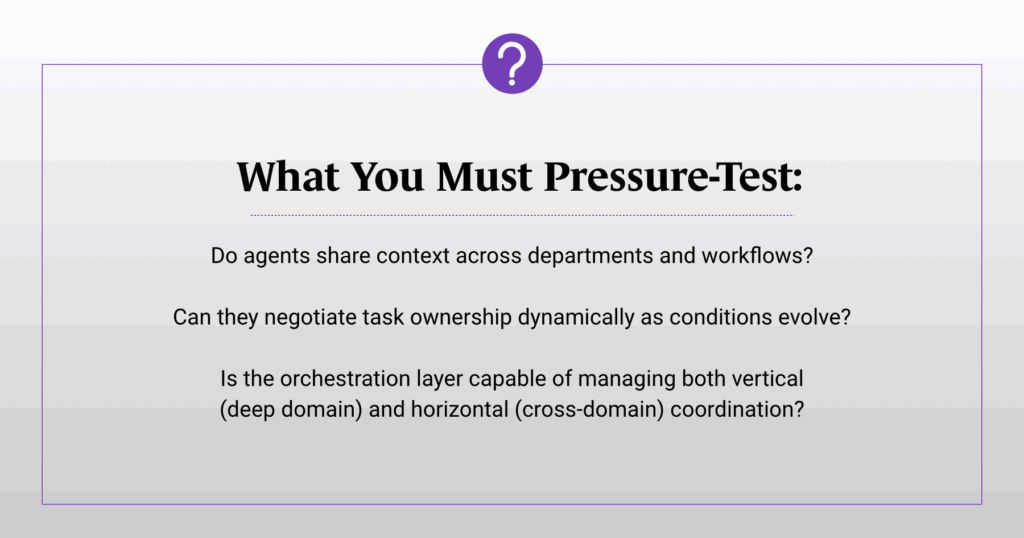
What Mature Agentic AI Gets Right:
The enterprise isn’t a single workflow; it’s thousands of interdependent ones. Agentic AI that can only optimize one function at a time simply replicates existing silos. True orchestration layers enable agents to operate across functions, balancing autonomy with shared context, escalating intelligently, and reducing cross-departmental friction without creating new blind spots.
4.How does agentic AI balance autonomy with human oversight?
Why This Becomes a Failure Point:
Autonomy isn’t absolute. In real businesses, certain decisions require human judgment, ethical consideration, or reputational discretion. Fully autonomous systems that lack calibrated human intervention points risk either overreach or paralysis.
For example, in customer service scenarios, agents may handle 90% of transactional inquiries autonomously but require clear escalation frameworks for emotionally charged, reputation-sensitive, or legally complex interactions.
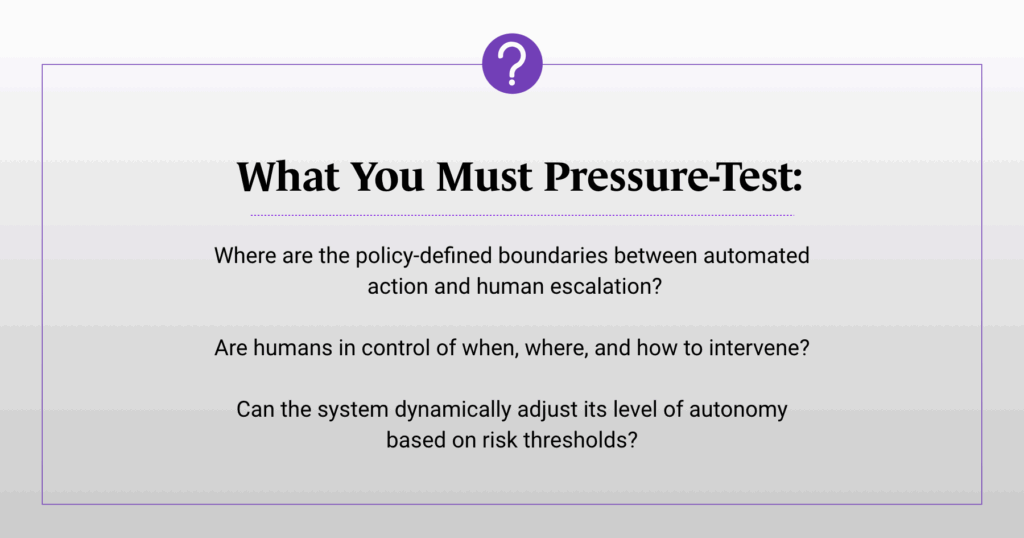
What Mature Agentic AI Gets Right:
The goal is not maximum autonomy. It’s controlled autonomy. Systems that are capable of acting independently where confidence is high, but that can hand off gracefully when ambiguity, risk, or human context demand oversight. This balance is what separates responsible AI governance from fragile automation.
5.Can the agents adapt to my domain’s messy, human, and regulated world?
Why This Becomes a Failure Point:
Most off-the-shelf AI excels in structured environments but falters in domains where human nuance, regulatory constraints, and context-specific exceptions dominate, as they do in financial services, insurance, healthcare, and higher education.
A claims processing agent in insurance faces vastly different complexity than an inventory agent in ecommerce, each requiring domain-specific reasoning, policy alignment, and regulatory guardrails.
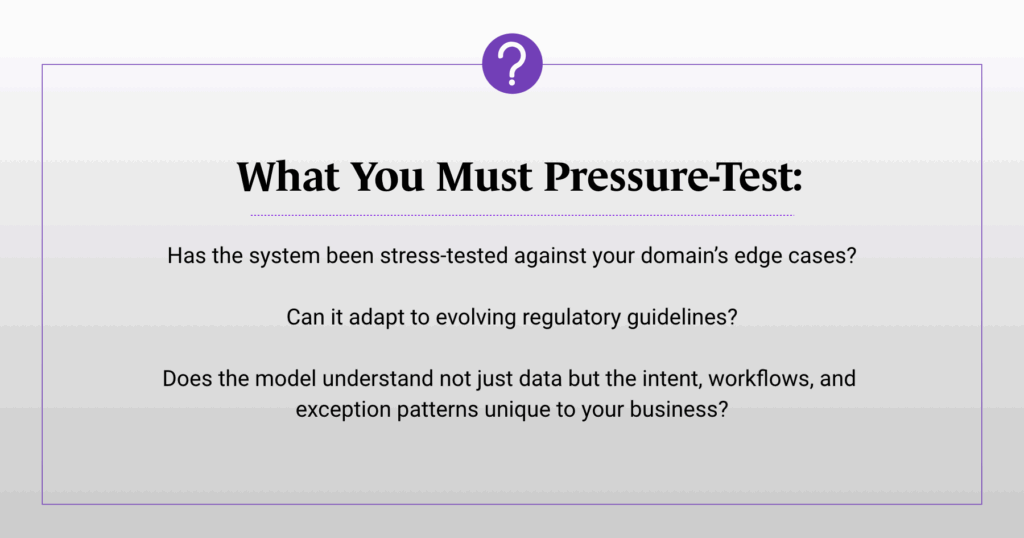
What Mature Agentic AI Gets Right:
Generic models rarely survive domain-specific complexity. Enterprise-ready agentic AI must combine foundational intelligence with domain-trained nuance, understanding not only what to do, but why it matters inside regulated, context-sensitive workflows. This is where domain partnership—not just technical capability—becomes decisive.
Agentic AI isn’t about asking more questions. It’s about asking the right ones early enough to design for reality, not theory. If organizations want to succeed, they should refrain from chasing model benchmarks or vendor promises, but instead, approach AI as a living system, one that demands orchestration, oversight, and domain mastery from day one.
